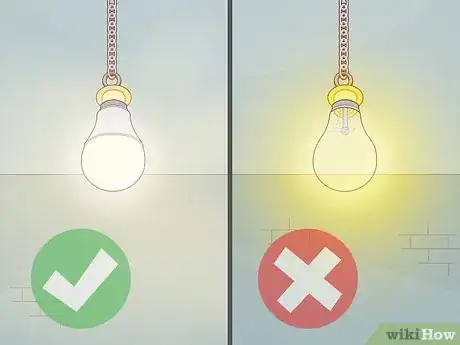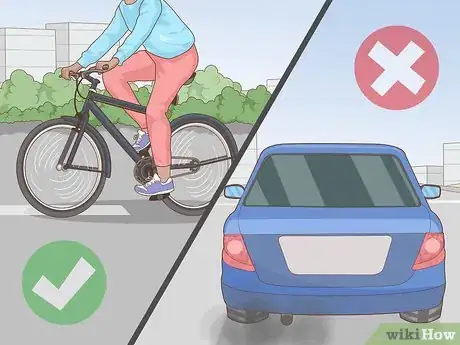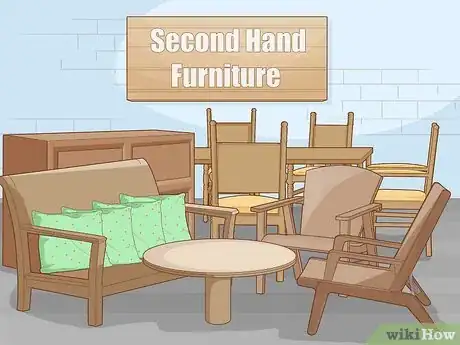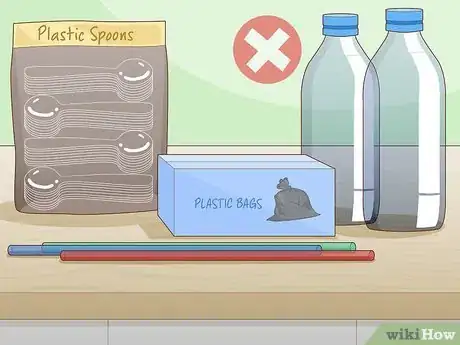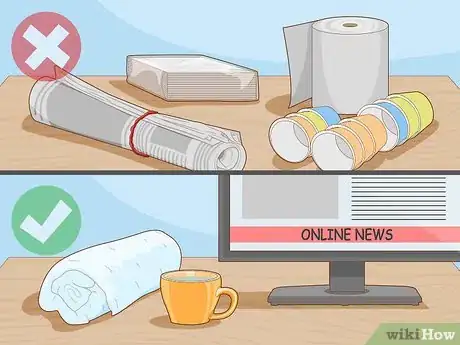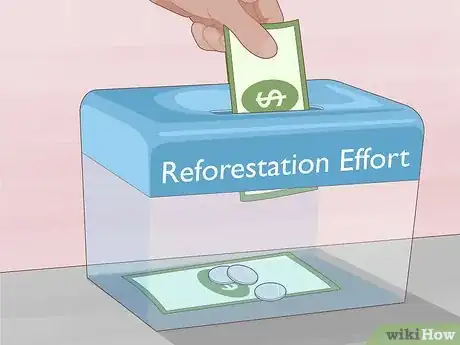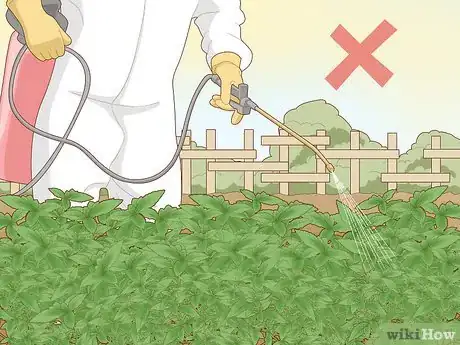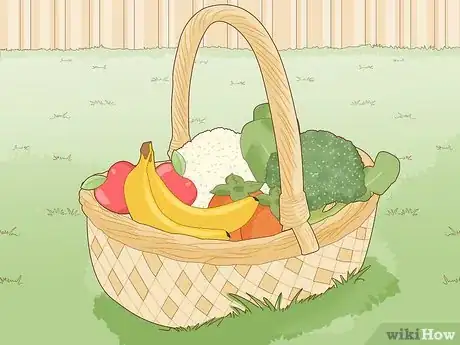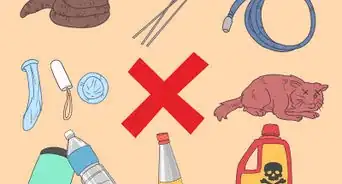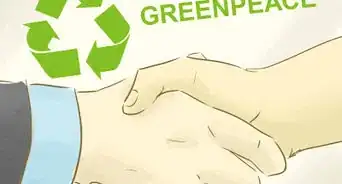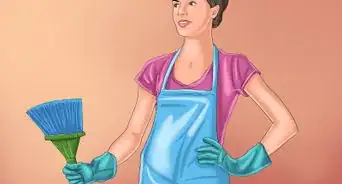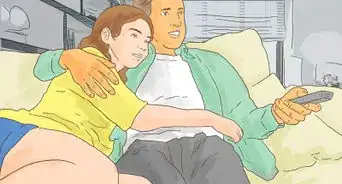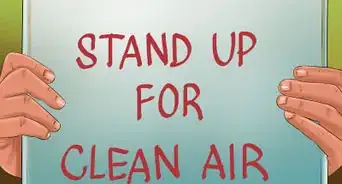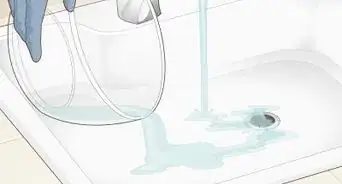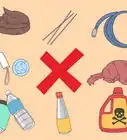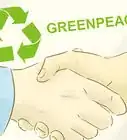This article was co-authored by Kathryn Kellogg and by wikiHow staff writer, Sophia Latorre. Kathryn Kellogg is the founder of goingzerowaste.com, a lifestyle website dedicated to breaking eco-friendly living down into a simple step-by-step process with lots of positivity and love. She's the author of 101 Ways to Go Zero Waste and spokesperson for plastic-free living for National Geographic.
There are 12 references cited in this article, which can be found at the bottom of the page.
wikiHow marks an article as reader-approved once it receives enough positive feedback. This article has 23 testimonials from our readers, earning it our reader-approved status.
This article has been viewed 554,630 times.
If you're concerned about land pollution, there's a lot you can do in your home and community to slow this environmental problem. Using these suggestions from organizations like the Environmental Protection Agency, you'll be able to take steps to reduce your waste, reverse deforestation, limit your chemical usage, and conserve energy, which will help prevent land pollution and create a cleaner planet.
Steps
Conserving Energy
-
1Reduce your electricity consumption. Burning fossil fuels to create electric power emits nitrogen into the air. This nitrogen is deposited back onto the land, leading to both soil and water pollution. To reduce your electricity consumption, turn off and unplug devices and equipment you aren’t using, such as televisions, printers, tablets, and computers.[1]
- Turn off lights in rooms you’re not in and use LED bulbs rather than fluorescent or incandescent bulbs.
- Select energy-efficient light bulbs and appliances, like washing machines, refrigerators, and air conditioning units.
- Use a programmable thermostat and keep the temperature between 77–80 °F (25–27 °C) in the summer and 64–68 °F (18–20 °C) in the winter.
-
2Use renewable energy sources. Solar, wind, and hydroelectric power are better for the environment than burning fossil fuels for energy.[2] Call up your power company and see if you can purchase your electricity from renewable sources. Or, install solar panels or a wind turbine to power your home and/or office![3]
- In many cases, you can receive a tax credit for using renewable energy sources.
Advertisement -
3Limit your vehicle emissions.[4] Vehicle emissions contain a lot of nitrogen which pollutes the air, water, and land. Burning gasoline also contributes to land pollution since drilling for oil releases contaminants into the soil. Rather than driving everywhere you need to go, carpool or take public transportation. If your destination is close enough, ride your bike or walk.[5]
- Flying also contributes to pollution. Try to consolidate or limit your business trips and vacations so as to reduce the number of flights you take each year.
Reducing Your Waste
-
1Limit your consumption of material goods. It takes a lot of energy and raw materials to manufacture everyday items. To reduce the amount of waste you produce, don’t buy something unless you absolutely need it![6] When an item you do own breaks, see if it can be repaired rather than replacing it. Also, buy used items, including furniture, clothing, toys, books, electronics, and decorations for your home.[7]
- If you only need to use something a few times, ask a friend or neighbor if you can borrow that item instead of buying a new one.
- Using biodegradable products also reduces the amount of waste you create.[8]
-
2Recycle as much you can. Landfills are a major contributor to land pollution. Instead of throwing away your waste, recycle as much of it as you can. Glass, plastic, paper and cardboard, and aluminum and other metals can all be recycled.[9]
- Sort your recyclables as per your recycling company or city municipality prefers.
- If you don’t have a recycling service, see if you can arrange for one to pick up recyclables from your home and office.[10]
Tip: Many American cities have recycling centers where you can drop off items for free. Search online for a center near you.
-
3Use less plastic. Plastic waste is clogging up landfills and oceans around the world. Avoid buying and using plastic products, such as plastic bags, cutlery, cups, straws, and bottles.[11] Another great way to cut down on plastic use is to buy items in bulk packaged in boxes instead of plastic containers.[12]
- Use fabric bags to carry your groceries, pack your lunch in reusable containers, and invest in reusable bags to store food items like leftovers and snacks.
Stopping Deforestation
-
1Reduce your paper consumption. The best way to do this is to avoid using disposable paper products. Paper towels, plates, cups, napkins, and other throwaway items are made from trees. Deforestation is a major cause of land pollution since it contributes to soil erosion and exposes the soil to contaminants. Instead of purchasing disposable paper products, opt for reusable plates and cloth towels and napkins.[13]
- Opt for paperless billing and cancel magazine and newspaper subscriptions.
- You can also limit your paper consumption by sending emails instead of snail mail, avoiding printing things unless you truly need to, and using both sides of a sheet of paper.
- When you do need to use paper, opt for recycled paper. And be sure to recycle any paper you do use!
Did you know? More than 30 million acres of forest are destroyed each year. Reducing your paper consumption can help limit how many trees are cut down for paper production.[14]
-
2Encourage your government to preserve forested areas. All types of forests are critical to the health of the environment. Reforestation can dramatically reduce land pollution. Write to or call your elected officials and ask them to take steps to stop deforestation. Ask them to crack down on illegal logging and encourage sustainable land use.[15]
- Furthermore, encourage them to support worldwide reforestation efforts.
- You can also donate time, money, or both to organizations dedicated to reforestation.
-
3Plant trees. Reforestation efforts can help reduce land and air pollution around the world. Planting trees increases biodiversity, stops soil erosion, reduces carbon monoxide buildup, and adds aesthetic value to the area. You can plant trees in your own community or work with worldwide organizations to plant trees in deforested areas.[16]
- If you plant trees in your own community, be sure to choose trees that are native to your region and will thrive in your specific climate.
- Check the laws in your area before planting trees on land other than your own.
Limiting Chemical Usage
-
1Avoid using fertilizers and pesticides. Both fertilizers and pesticides leach into the soil and contaminate it. This contaminated soil is often no longer able to support the growth of crops, leading to less land available for food production. If you have a farm, yard, or garden, avoid applying pesticides or fertilizers to your soil.[17]
- Use natural or organic fertilizers instead of chemical ones.
Tip: There are many natural pest-control solutions. For instance, introducing ladybugs will eradicate an aphid problem. Also, companion planting can reduce the need for pesticides.
-
2Dispose of toxic chemicals properly. Household cleaning products, solvents, paints, automotive fluids, and aerosol containers all contain toxic materials. Rather than tossing these items in the trash, where they will leach into the soil in a landfill, take the time to figure out how to dispose of them properly. Read the label on each container as well as the material data safety sheet to figure out the best way to get rid of each type of chemical.[18]
- Be sure to store these kinds of chemicals in spill-proof containers as well.
-
3Buy organic foods. Organic foods are grown without the use of pesticides. Select fruits and veggies that are certified organic to reduce chemical pesticide usage in the agriculture industry. Though you may spend a little more money, organic foods are better for both your health and the planet![19]
Expert Q&A
-
QuestionWhat can students do to help reduce pollution?
 Kathryn KelloggKathryn Kellogg is the founder of goingzerowaste.com, a lifestyle website dedicated to breaking eco-friendly living down into a simple step-by-step process with lots of positivity and love. She's the author of 101 Ways to Go Zero Waste and spokesperson for plastic-free living for National Geographic.
Kathryn KelloggKathryn Kellogg is the founder of goingzerowaste.com, a lifestyle website dedicated to breaking eco-friendly living down into a simple step-by-step process with lots of positivity and love. She's the author of 101 Ways to Go Zero Waste and spokesperson for plastic-free living for National Geographic.
Sustainability Specialist Try starting a composting program at your school. You can also start growing a school garden to learn more about where food comes from, growing local, and how both impacts sustainability. A lot of schools have also started using real lunch trays instead of disposable lunch trays and phasing out beef in favor of more climate-positive foods.
Try starting a composting program at your school. You can also start growing a school garden to learn more about where food comes from, growing local, and how both impacts sustainability. A lot of schools have also started using real lunch trays instead of disposable lunch trays and phasing out beef in favor of more climate-positive foods. -
QuestionHow do I reduce garbage?
 Community AnswerRecycle often, reuse what you can or donate what you can't but can still be used, and reduce the amount of waste you create.
Community AnswerRecycle often, reuse what you can or donate what you can't but can still be used, and reduce the amount of waste you create. -
QuestionHow do I recycle shoes?
 Community AnswerYou can mail shoes to a recycling location. To minimize excess shipping and packing material, collect some old sneakers from friends to throw in the box with your own shoes. If your shoes are only slightly worn, donate them to a local charity.
Community AnswerYou can mail shoes to a recycling location. To minimize excess shipping and packing material, collect some old sneakers from friends to throw in the box with your own shoes. If your shoes are only slightly worn, donate them to a local charity.
References
- ↑ https://www.epa.gov/nutrientpollution/sources-and-solutions-fossil-fuels
- ↑ Kathryn Kellogg. Sustainability Specialist. Expert Interview. 28 June 2019.
- ↑ https://www.epa.gov/nutrientpollution/sources-and-solutions-fossil-fuels
- ↑ Kathryn Kellogg. Sustainability Specialist. Expert Interview. 28 June 2019.
- ↑ https://www.epa.gov/nutrientpollution/sources-and-solutions-fossil-fuels
- ↑ Kathryn Kellogg. Sustainability Specialist. Expert Interview. 28 June 2019.
- ↑ https://www.epa.gov/recycle/reducing-waste-what-you-can-do
- ↑ https://helpsavenature.com/prevention-of-land-pollution
- ↑ https://www.epa.gov/recycle/recycling-basics
- ↑ Kathryn Kellogg. Sustainability Specialist. Expert Interview. 28 June 2019.
- ↑ Kathryn Kellogg. Sustainability Specialist. Expert Interview. 28 June 2019.
- ↑ https://www.clinmedjournals.org/articles/ijtra/international-journal-of-toxicology-and-risk-assessment-ijtra-5-021.php?jid=ijtra
- ↑ https://sciencing.com/prevent-land-pollution-23063.html
- ↑ https://community.aiim.org/blogs/dennis-kempner/2016/12/06/impacts-of-paper-on-the-environment
- ↑ https://onetreeplanted.org/pages/reforestation
- ↑ https://www.denr.gov.ph/index.php/news-events/regional-releases/1873-tree-planting-improves-quality-of-life
- ↑ https://sciencing.com/prevent-land-pollution-23063.html
- ↑ https://www.soils.org/about-soils/contaminants/
- ↑ https://www.cbd.int/doc/bioday/2008/ibd-2008-framing-booklet-en.pdf
About This Article
To prevent land pollution, reduce the amount of paper you use by signing up for digital bills and subscriptions. Try to consume fewer material goods and buy products made with minimal packaging to keep wastefulness to a minimum. Also, limit your use of harsh chemicals and cleaners, and be sure to dispose of them properly when you do use them. Finally, recycle your discarded glass, plastic, paper, cardboard, and aluminum items so that they don't end up in a landfill. To learn about using renewable energy sources, read on!
